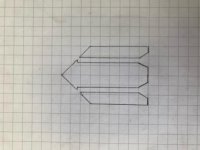tylersteez
Aluminum
- Joined
- Jul 9, 2019
We have a huge chamfering job that requires a 45 degree chamfer on each end of a piece of .087" diameter stainless wire with a depth of .010" to .020". I made a simple jig on the bridgeport that we are clamping to a belt sander that allows for just the corner of the wire to contact the belt sander at a 45 degree angle. it is working, however the belt wears and we have to move the jig over to a fresh part of the belt often and dial it back in.
Tossed around the idea of one of these types of drill chamfering tools however all of the ones available online only go down to .125". they also don't have a depth stop. Deburring External Chamfering Tool, Chamfer Tool Deburring External Drill High Speed Stainless Steel Burr Removal Bit Quickly Repairs Damaged Metal External Chamfer Deburring Tool (Silver-2Pack) - - Amazon.com
I've attached a basic drawing of how the jig I made works. it's double-sided incase the operator bumps it into the belt too much and sands it down
any ideas on improving? I'm not a fan of using the belt sander. diamond wheel on a bench grinder maybe? never bought a diamond wheel before so not sure what the cost looks like.
Tossed around the idea of one of these types of drill chamfering tools however all of the ones available online only go down to .125". they also don't have a depth stop. Deburring External Chamfering Tool, Chamfer Tool Deburring External Drill High Speed Stainless Steel Burr Removal Bit Quickly Repairs Damaged Metal External Chamfer Deburring Tool (Silver-2Pack) - - Amazon.com
I've attached a basic drawing of how the jig I made works. it's double-sided incase the operator bumps it into the belt too much and sands it down

any ideas on improving? I'm not a fan of using the belt sander. diamond wheel on a bench grinder maybe? never bought a diamond wheel before so not sure what the cost looks like.

